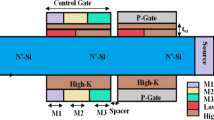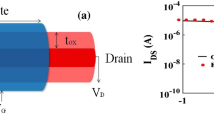Abstract
The application of artificial neural network (ANN) can give a very accurate and fast model for semiconductor devices used in circuit simulations. In this paper, we have applied multi-layer perceptron (MLP) neural network based on limited memory Broyden–Fletcher–Goldfarb–Shanno (L-BFGS) method to model the flexible metal-oxide thin-film transistors (TFTs). An improved particle swarm optimization (PSO) is employed to find suitable initial parameters for the ANN model, which consists of a centroid opposition-based learning algorithm and a mutation strategy based on Euclidean distance to enhance the searching ability further. This hybrid modeling routine can improve the accuracy of predictions of both the I–V and small signal parameters (\(g_d\), \(g_m\), etc.) characteristics, which are in good agreement with experimental data and fully demonstrate the validity of the proposed model. Furthermore, the model is implemented into a simulator with Verilog-A. The circuit-level tests of TFT show that the ANN compact model with PSO enables accurate performance estimation of metal-oxide TFT circuits.








Similar content being viewed by others
References
Zhang, L., Huang, C., Li, G., Zhou, L., Wu, W., Xu, M., Wang, L., Ning, H., Yao, R., Peng, J.: A low-power high-stability flexible scan driver integrated by IZO TFTs. IEEE Trans. Electron. Devices 63(4), 1779–1782 (2016)
Jeong, J.K.: The status and perspectives of metal oxide thin-film transistors for active matrix flexible displays. Semicond. Sci. Technol. 26(3), 034008 (2011)
Fang, J., Deng, W., Ma, X., Huang, J., Wu, W.: A surface-potential-based DC model of amorphous oxide semiconductor TFTs including degeneration. IEEE Electron Device Lett. 38(2), 183–186 (2017)
He, H., He, J., Deng, W., Wang, H., Liu, Y., Zheng, X.: Trapped-charge-effect-based above-threshold current expressions for amorphous silicon TFTs consistent with Pao-Sah model. IEEE Trans. Electron Devices 61(11), 3744–3750 (2014)
Tsormpatzoglou, A., Hastas, N.A., Choi, N., Mahmoudabadi, F., Hatalis, M.K., Dimitrialdis, C.A.: Analytical surface potential-based drain current model for amorphous InGaZno thin film transistors. J. Appl. Phys. 114(18), 184502–1845026 (2013)
Garcia, R., Mejia, I., Tinoco, J., et al.: A compact drain current model for thin-film transistor under bias stress condition. IEEE Trans. Electron Devices 65(5), 1803–1809 (2018)
Bahubalindrun, P., Tavares, V., Barquinha, P., Oliveira, P., Martins, R., Fortunato, E.: InGaZnO TFT behavioral model for IC design. Analog Integr. Circuits Signal Process. 87(1), 73–80 (2016)
Hayati, M., Rezaei, A., Seifi, M.: CNT-MOSFET modeling based on artificial neural network: application to simulation of nanoscale circuits. Solid-State Electron. 54(1), 52–57 (2010)
Hornik, K., Stinchcombe, M., White, H.: Multilayer feedforward networks are universal approximators. Neural Netw. 2(5), 359–366 (1989)
Tavares, V., Candido, D., Barquinha, P.: a-GIZO TFT neural modeling, circuit simulation and validation. Solid State Electron. 105, 30–36 (2015)
Liu, D., Nocedal, J.: On the limited memory BFGS method for large scale optimization. Math. Program. 45(1), 503–528 (1989)
Eberhart, R., Kennedy, J.: A new optimizer using particle swarm theory. In: Proceedings of the Sixth International Symposium on Micro Machine and Human Science, pp. 39–43 (1995)
Ismail, A., Jeng, D.S., Zhang, L.: An optimised product-unit neural network with a novel PSO-BP hybrid training algorithm: applications to load-deformation analysis of axially loaded piles. Eng. Appl. Artif. Intell. 26(10), 2305–2314 (2013)
Hou, C., Yu, X., Cao, Y., Lai, C., Cao, Y.: Prediction of synchronous closing time of permanent magnetic actuator for vacuum circuit breaker based on PSO-BP. IEEE Trans. Dielectr. Electr. Insul. 24(6), 3321–3326 (2017)
Wang, H., Li, H., Liu, Y., Li, C., Zeng, S.: Opposition-based particle swarm algorithm with Cauchy mutation. In: IEEE Congress on Evolutionary Computation, pp. 25–28 (2007)
Peng, Y., Deng, W., Wu, W., Luo, Z., Huang, J.: Hybrid modeling routine for metal-oxide TFTs based on particle swarm optimization and artificial neural network. Electron. Lett. 56(9), 453–456 (2020)
Zhang, L., Chan, M.: Artificial neural network design for compact modeling of generic transistors. J. Comput. Electron. 16(3), 825–832 (2017)
Tizhoosh, H.: Opposition-based learning: a new scheme for machine intelligence. In: Conference on Intelligent Agents, Web Technologies and Internet Commerce. 1, pp. 695–701 (2005)
Xu, Q., Wang, L., Hei, X., Zhao, L.: A review of opposition-based learning from 2005 to 2012. Eng. Appl. Artif. Intell. 29(3), 1–12 (2014)
Rahnamayan, S., Jesuthasan, J., Bourennani, F., Salehinejad, H.: Computing opposition by involving entire population. In: IEEE Congress on Evolutionary Computation, pp. 6–11 (2014)
Wei, T., Yu, F., Huang, G., Xu, C.: A particle-swarm-optimization-based parameter extraction routine for three-diode lumped parameter model of organic solar cells. IEEE Electron Devices Lett. 40(9), 1511–1514 (2019)
Chen, Z., Xu, W., Wu, J., Zhou, L., Wu, W., Zhao, J.: A new high gain operational amplifier using transconductance-enhancement topology integrated with metal oxide TFTs. IEEE J. Electron Devices Soc. 7(1), 111–117 (2018)
Huang, T., Fukuda, K., Lo, C., Yeh, Y., Sekitani, T., Someya, T., Cheng, L.: Pseudo-CMOS: a design style for low-cost and robust flexible electronics. IEEE Trans. Electron. Devices 58(1), 141–150 (2011)
Wu, W., Li, G., Xia, X., Zhang, L., Zhou, L., Xu, M., Wang, L.: Low-power bi-side scan driver integrated by IZO TFTs including a clock-controlled inverter. J. Disp. Technol. 10(7), 523–525 (2014)
Iñiguez, B., Xu, Z., Fjeldly, T.A., Shur, M.S.: Unified model for short-channel poly-Si TFTs. Solid-State Electron. 43(10), 1821–1831 (1999)
Acknowledgements
The authors would like to thank New Vision Opto-Electronic Technology Co., Ltd., China, for data support of IZO-TFT devices and circuits. This work was supported by the Guangdong Natural Science Foundation under Grants 2018A030313018 and 2020A1515010567.
Author information
Authors and Affiliations
Corresponding author
Additional information
Publisher's Note
Springer Nature remains neutral with regard to jurisdictional claims in published maps and institutional affiliations.
Rights and permissions
About this article
Cite this article
Deng, W., Zhang, W., Peng, Y. et al. Compact modeling of metal-oxide TFTs based on artificial neural network and improved particle swarm optimization. J Comput Electron 20, 1043–1049 (2021). https://doi.org/10.1007/s10825-020-01641-z
Received:
Accepted:
Published:
Issue Date:
DOI: https://doi.org/10.1007/s10825-020-01641-z




